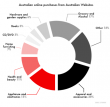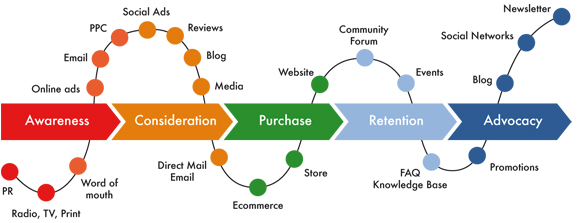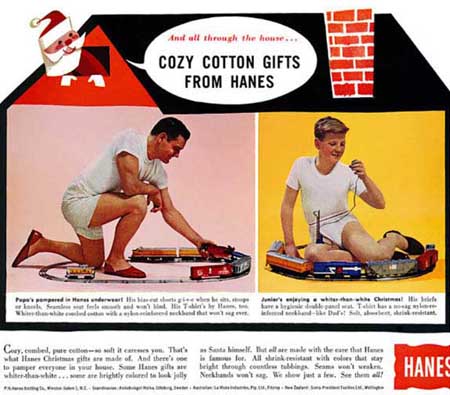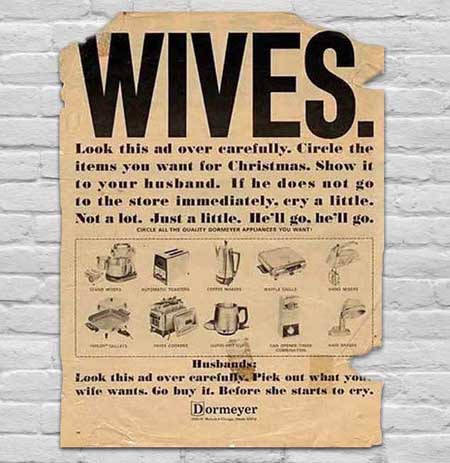Trust me, I'm in advertising...

10 years ago when I started my own agency, an account director mate left the industry to become a real-estate agent. I remember thinking it was the only place he could go that had a lower standard of trust than we advertising types.
Last week he told me it was a great move financially, he reckons 99% of people in advertising are really smart, whereas he’s happy competing with the 99% of real estate agents he’s found to be really ordinary. If we are that smart, why can’t we lift our own profile, beyond the bottom of the heap for trusted professions?
Trust in advertising? This is not an oxymoron.
Unfortunately, the perception of our industry is on a par with used car salesmen, yet our legal obligations, indeed our personal liability, dictate our practices are squeaky-clean.
In Australia, like most things, our industry is regulated and kept on the honest path by a series of laws and regulatory bodies. You wouldn’t know it.
The 2011 senate inquiry into outdoor advertising standards found only 0.01% of ads were found to be bad, i.e. sexist, likely to offend or straight out untruthful. Yet when prompted on ABC radio, the senator leading the inquiry said that if we don’t clean up our act under self regulation, he’ll "pull out the big stick and regulate" us.
Would you trust a politician to decide whether marketers are trustworthy?
In Europe, clergy are experiencing a decline in confidence levels and politicians are in last place. Our peers don’t rate much better than we do here, with over half of Europeans surveyed* saying they don’t like journalists, marketing specialists or advertising experts.
*Source: GfK Trust Index in spring 2010
I can understand why journalists are suddenly on the nose – the phone hacking scandal at Rupert's tabloid News of the World has in the words of one shareholders action group "laid bare a striking lack of stewardship and failure of independence." The board had been unable to set a "strong tone-at-the-top" about unethical business practices.
Australians generally are a trusting lot. When it comes to believing what our fellow citizens say, Australia on a trust index score of 92 ranks ahead of the U.S. (78.8) and U.K (61), just behind New Zealand (102) and way behind China on 120.9.

Source: ASEP/JDS data bank 2011
So where do Australia’s “ad people” sit on the trust index today?
Who we really trust is no real surprise:
1. Paramedics
2. Firefighters
3. Pilots
4. Rescue volunteers
5. Nurses
At the bottom of the pile are
41. Taxi drivers
42. Real estate agents
43. Car salesmen
44. Politicians
45. Tele-marketers
Source: Readers Digest Austrlalia’s most trusted professions poll 2011
Before you think ad madmen aren’t so bad after all, the only reason they’re not last on this list is because they aren’t included in the survey. Tele-marketers are the closest category, so let’s just accept advertising and marketing guys are way down there. How did we end up down at the bottom with pollies, and what do we need to do to elevate our role to a similar level of respect as other service providers like engineers, doctors and architects?
Advertising first took off in America in 1800s when snake oil makers discovered the return on investment of promoting something of little value with amazing claims in the press. In Australia last year the most damage to our credibility was the public complaints about the posters advertising Advanced Medical Institute’s cure for under performance in bed. It was bad enough they were bad ads, the real breach of trust was the pitch was a fraud. Most of those with a desire to last longer in bed were overcharged for a treatment that generally didn’t deliver on the promise.
As a professional I feel we would be better off refusing to work for these types of people. It didn’t harm Bill Bernbach’s career when he told prospects he wouldn’t accept their business if their product didn’t live up to his standards.
(Glenn Mabbott would like to declare his interest as a sitting member of The Communications Council’s Policy Committee, which aims to raise industry standards through the Accreditation Scheme. UNOmarcomms was one of the first independent agencies in Australia to gain accreditation.)
Are today’s retail ads bland, bland, bland?

Are today’s retail ads bland, bland, bland? This was the question posed by AdNews last week after Dick Smith launched a new brand style ad campaign. If you missed it, here is a cut down of my contribution to the debate.

Dick Smith was an innovator
He built a new category with advertising and brochus that gave Australia’s cardigan wearing tinkerers access to an Alladin’s cave of electronics stuff to play with in their garages. What proved Dick really clever was his ability to sell his growing challenger brand to Woolworths and then go on to innovate time and again. With Australian Geographic and then his Australian Made products, Dick was a natural at creating marketing campaigns that resonated with the public mood of those times.
Contrast this with another retail innovator of Smith’s era, Gerry Harvey. Gerry also made his first million in his early twenties with ads for whitegoods and appliances that yelled, “Why pay more?

Is Gerry a clever Dick?
Gerry didn’t sell his business and continues to be the biggest retail advertiser in the country with ads that follow the same tired formula of thirty years ago. We all know the pitch: yell loud enough and people will rush in to grab a bargain. Except increasingly we’ve learnt to treat those ads as repetitious nagging. We’ve moved on to better retail experiences, which are likely to be online.
It’s time the majority of retailers looked at the current crop of retail innovators, like Net-a-Porter that has just released a new magazine iPad app that makes shopping an exciting, contemporary experience. Or this great campaign in Korea for Tesco’s challenger brand, Home Depot.
This article first appeared in AdNews, 21/10/11
A lateral way to increase retail shelf space: use a billboard
Watch this short video of how Tesco challenged the number 1 retailer in Korea by creating a virtual store.
What’s the next killer app?
The latest stats show Australians are the number 2 adopters of smartphones. And this year, Tablets and iPads are set to outsell mobiles, Australians will buy 1.2 million of them*. In the last couple of years the fastest increase in marketing online has been with using video, so we believe the next big thing for marketers will be video over smart mobile devices.

Ask us about the app factory that will let you make the most of video content. (Soon to be launched by UNO with our partners at Mass Media Solutions.)
*Telsyte mobile device update 2011.
73% of CEOs think marketers "Lack Business Credibility"
According to damning research by the Fournaise Marketing Group, marketers are not the business growth generators they should be.*
The gist of the findings of an Asia wide survey of CEOs is that management believe their own marketing departments are in a world of their own. They believe marketers speak in jargon and are not contributing any value to the business. From my experience you can’t blame most business owners for thinking this way, especially in Australia. Too few businesses have ever had a good marketer sitting round the table at board level, championing the power of marketing to generate wealth.
Marketers need to talk the language of business outcomes
As in “how can marketing get a better return on investment”. Otherwise marketing will remain a misunderstood black art not worthy of the attention of three quarters of CEOs. The vast majority of businesses will thus miss out on the huge opportunities that insightful marketing can deliver when it is woven through the entire business process.
Meanwhile there are a handful of businesses doing better than the rest because they have value-adding marketers on the team. These marketers, obsessed with return on investment, are recognised as an integral part of the senior management team. They are helping their businesses punch above their weight in the following ways…
- Overcome competition based purely on price
- Prevent decline of sales
- Hold on to existing customers
- Build qualified sales leads
- Change the perceived quality of a product
- Revitalise tired brands
- Boost staff morale
- Speed the development of new markets
- Speed product trial and acceptance
- Help businesses raise capital more easily
- Build the value of a business for sale
ROI marketing works
For 100 years Coke has proven it, people from first world countries to third choose Alabama’s black sugar syrup even though it doesn’t taste as good as Pepsi’s. That’s the power of consistent marketing. Perrier taught us to pay more for mineral water than petrol. Branson has convinced Australians to fly Virgin despite having a deplorable record of taking off late, (and you still have to pay for your sandwiches). And thanks to marketing Apple has built a brand that is hugely profitable, marketing has enabled them to sell often inferior spec’d products at a premium to specialist manufacturers like Nokia and HP.
CEOs needn’t fear marketing speak. Business decision makers who embrace marketing with an open mind can still enjoy a sense of control by implementing a test and learn approach. Any marketer worth listening to understands the value of having the results of their work tracked. If it isn’t measured, it isn’t managed. A marketing program that IS managed WILL deliver better results than mindlessly sticking to what the company has always done, or jumping blindly into the latest thing.
ROI Marketing can make a big difference to any sized business, in any category
So what can ROI marketing do for you? My experience has shown me whatever the category, from Watties baked beans to Brita water, Splash Clinic cosmedical treatments to City Index CFDs, a test and learn marketing program can turn good businesses into category leaders.
Read MoreTwo thirds of Australians are using social media. Two thirds of those use it to decide what to buy.*
Social Media Marketing (SMM) is growing, the latest figures show Social Media is becoming a mainstream influence in the purchase decision process. UNO are members of the Australian Interactive Media Industry Association. Together with Sensis, AIMIA surveyed 803 Australian consumers and 1,944 Australian businesses to determine how social media channels are being used. 50% of corporations now have a social media presence, the majority on facebook. Just 14% of small businesses use social media.
Proportion who have Social Media presence

Proportion who have Social Media presence

Social networking site usage by age and gender

Here are 10 ways you can make more of Social Media in your marketing communications mix:
- Start now for free. If your business is consumer facing, get a facebook page, it’s free.
- For B to B, skip facebook. Focus where business decision makers are active. Join LinkedIn. Follow relevant associations and groups, join industry forums and post comments on articles.
- Share your knowledge. Your business is your passion; tell it how you see it where you can add value to a conversation. No need to sell, just build your credibility as an expert and you’ll be increasing the standing of your businesses.
- Don’t post as anonymous. Out yourself. The CEO of a solar hot water manufacturing company follows chatrooms where plumbers share advice. His comments to tradies‘ questions demonstrate he’s in touch with his market. I suspect his competitors are unaware such forums even exist.
- Put someone in charge of your Social Media. Empower a person within your business who is passionate and keen to have a dialogue with customers. If you don’t have anyone internally, outsource.
- Tweet. Reinforce your position as an industry expert by tweeting and re-tweeting about relevant content that others have shared.
- Blog. Blogs and reviews have a big influence on buying decisions, with 63% of social media users reading reviews before making a purchase decision.
- Be regular. Respond quickly.
- Integrate social media. Integrate content with your promotions and product campaigns. Measure. Track.
- Video is the future. It’s the fastest growing area online because it’s easy to share. It’s not enough to post a television commercial on YouTube because no-one will look for it. Be creative, film an interview with an expert, or shoot a behind the scenes glimpse that showcases something you do well.
Social Media can deliver a measurable ROI. No wonder businesses are spending 5% of their marketing budgets managing and creating content for social media.
The good news is that any business that has collected data on their customers is sitting on their own potential gold mine. Rather than spend money trying to appeal to new prospects by running press or even online ads, you will get a much better return on investment by adding some intelligence to the way you manage your data.
Give your CRM some Data Intelligence
Most data is in such a mess it offers little insight to business owners. To turn it into a powerful tool to enable you to communicate with your customers requires a clean, intelligently organised database.
The place to start to release the value from the mountain of data you already have is to give it to an expert to wash it.
You’d be surprised how many emails and addresses are wrong, repeated or out of date. You can’t begin to measure response rates until you know the data you have is clean. It’s better to measure the response from 10,000 real customers than to assume you’re sending offers out to say 30,000 on a dirty list.
Once you have a clean list, your data then needs to be structured and categorized with the aim of maximising its usefulness for marketing purposes. There are then some things you can do straight away to not only deliver quick profits today, but also set you on the path to delivering what customers will want in the future.
Fast profits can come from testing and tailoring offers to:
- up-sell, getting customers to buy more valuable products from you
- cross-sell, encouraging them to add something else to what they usually buy from you
- increase purchase frequency, by building loyalty and giving them more reasons not to be tempted by your competitors
So get the experts in quick smart to professionally clean your data so you can secure the future of your business. Let those who continue to spend big to tempt new prospects pay the price.
Read More
What will it take for retailers to stay in business in this rapidly changing global economy? Futurist Ross Dawson commented in a recent blog that if you expect your business to look the same in 10 years as it does today, expect to be out of business.
Who’d have thought ten years ago that Woolworths would be the biggest owner of pubs and bottle shops today? Constant change is the only way to stay competitive, which explains why Woolworths just bought Cellarmasters for $340million. Kevin Luscombe recognises the future includes database marketing, Cellarmasters “will enable us to serve a whole new customer segment in terms of the direct marketing channel.”
eCRM drives online sales
Cellarmasters has the largest databases of drinkers of premium wines in Australia. For any competitor to stay in the premium wine business they’ll need to at the very least match the way they apply an eCRM program to their database.
Once a database has been professionally cleaned, you can start to mine your database and build a series of profiles of your customers. Using that intelligence will deliver a better ROI on your marketing. You’ll get a better result cross selling Pinot Gris to customers who are heavy purchases of Sauvignon Blanc. With profiles of your customers it becomes practical to promote a 20 case limited offer Coonawarra cleanskin, you simply email your regular purchasers of Cabernet. With data intelligence, while you offer a bonus with purchase of single malt to spirits drinkers, beer drinkers automatically receive a different offer.
Very few customers want to be constantly bombarded with promotions that are obviously being sent to the masses. They will reward targeted offers that demonstrate you understand them as an individual with stronger loyalty.
Your customers know what they like and will actually tell you what they want if you bother to track their behaviour, or quite simply ask them. Every marketing activity, from a mailer or catalogue to a visit to your store, each phone enquiry and every online order is an opportunity for you to measure what works and what can be improved.
ROI marketing will drive e-commerce
Every dollar you spend on marketing should and can be measurable. You don’t actually have to be a futurist to stay in business, with data intelligence you can keep track of where your customers’ needs are leading and continuously adjust and improve to keep up with them.
Read More
Bernard Salt earns a living as a demographer. That’s the art of taking research data and painting a picture of who we are and what we think and do. Before you tune out thinking he’s just another propeller head making money off the back of lies, damn lies and statistics, consider for a moment what you’d give as a business to know where the next big opportunity for making money is, before it happens.
How do entrepreneurs know where to invest today in what will be the sweet spot tomorrow? What did the savvy few who bought franchises in McDonalds in the eighties know? Or the food services that were ready to be part of café culture as we left tea drinking behind?
If you were a tea manufacturer in the 70s Australia’s demographics could have predicted that your volumes were about to decline. The move from a society of tea drinkers to the blossoming of café culture at the turn of this century was a consequence of something that happened in the 1950s. The wave of immigrants from Italy and Greece post war had kids, grew wealthy and infused our Anglo society with a Mediterranean café culture which saw Australians move onto the footpaths and embrace machiattos and cappuccino with biscotti in preference to sitting indoors with a cuppa Bushells and an iced Vovo.
At a Family Business Australia breakfast, Bernard explained the simple truth that the composition of Australia is what drives business growth. And decline. Seems obvious, yet even the high fliers at BHP and the big four banks pay Bernard to keep them abreast of what should be self evident. It’s easier to grow a business and be profitable in a category of growing demand than to compete for a share of a shrinking one.
Change managment – there's money in tea
Follow the demographic trends that will shape what Australians will look like in the next decade and consequently what consumers will be asking for. Today there is a shift away from European immigration to Asian as these stats on fastest growth and loss by place of birth show.

Prediction: Start thinking about tea and noodles not coffee and pasta.
Super was yesterday’s money maker
In the last decade the biggest growth in financial services has been in superannuation. The SMSF category has doubled its share to be the largest segment at huge cost to growth of retail funds as boomers take more interest in their money in super. Industry funds have also grown share with a low fee proposition and the locked in stream of contributions via the super guarantee levy from a membership base that traditionally wasn’t saving much. But that’s today’s boom business, tomorrow it will change, again because of a shift in demographics.
The makeup of working Australia is about to fall off a cliff, as the boomers retire and are replaced by… no-one:

The age at which boomers will retire, now on average 58, as well as the length they can expect to live has also profoundly changed in just a generation:

Prediction: Cashed up retirees who will live for 20+ years will want to travel, eat out, be entertained, live in a city apartment or by the sea and to pay for it all need a retirement pension plan that will last the distance. They’ll be looking at ETFs and annuities.
Bernard Salt has a pretty good idea of what tomorrow looks like. It’s up to you to see how you can position your business today to be ready to reap the rewards of a growing market category before it’s the next big thing.
Read MoreDoes your business have a brand policeman?

When did you last check your brand imagery and how consistently you are projecting your business to customers and stakeholders? Have you done a complete audit of all your “touch points”? Who in your company has the authority to enforce standards?
Large corporations have entire departments looking after how the image they present visually. They have realised the value created by consistent repetition of the company brand marks alongside the product or service it delivers.

Most businesses fail to present themselves as professionally as big brands and end up with a brand “look” that has more in common with a camel than a racehorse. This occurs organically, by allowing too many people to make piecemeal decisions every time something is needed.
There are so many pieces that make up the complete picture of your brand, from a new business card to printing a brochure or sending an email offer. Each is an opportunity to build brand “credits”, or a risk for someone to go off on a tangent.
A complete audit of all your brand “touch points” would cover:
• Internal signage
• Building signage
• Banners
• Vehicle signage
• Advertising
• Email signatures
• Website
• eNewsletter templates
• Fax formats
• Letterhead
• Business cards
• Presentation folders
• Flyers
• Sales force and sales kits
• Product sheets, warranty forms
• Order forms
• Invoices
• Branding on your products
• Point of sale
• Price tickets and notices
Setting brand standards with a professionally developed Style Guide
Brand guidelines (also called a Style Guide) should cover all of the things in the list, and have specific rules for each element. For instance, how your logo is used would cover these specifications:
Colours
• Print: CMYK or Pantone reference
• Digital: RGB
• Mono, reverse,
• Vector files for artwork production.
Size guidelines - how small can it still reproduce?
Usage guidelines - clear space, location on the page, hierarchy with other symbols.
A Graphic Designer with credentials in this area can produce your Style Guide.
Enforcing your brand style
Your creative agency can act as your deputy and arm you with a password protected online archive of logos, images, artwork formats and templates.
Many businesses also find having a professionally developed Style Guide available, as a reference document for staff and suppliers, helps enforce brand rules making it easier to keep the company image under control.
Finally, someone qualified within your company needs the power to enforce the Brand guidelines. It is possible to mandate that all work using the company brand mark is approved by this person before it goes into production.
Success through consistency
Every business can benefit from designing formal brand “rules” so they can weave simple and consistent imagery through the company’s everyday operations. If you have a good product your customers will come to associate that product with your consistently delivered brand mark.
Read More
There’s more to ecommerce than GST
Funny how Harvey Norman and other retailers are running to the regulator with the sob story that they are losing sales to overseas online providers who don’t pay GST. Time for a reality check, they are losing sales because they are slow in changing their business models to keep up with consumer behaviour. 6 months ago I flagged the stats showing how quickly online sales were growing and the failure of our retailers to keep up with the trend.

Consumers reward innovation
It’s how Gerry Harvey made his first millions when, in his twenties, he founded the first category killer electrical discount store, Norman Ross. You don’t have to be young to be innovative; you just have to give consumers what they want in new and exciting ways. Today consumers increasingly are researching and shopping online. In a few years what they want will be something most of us have yet conceived, and more than likely Apple’s Steve Jobs, aged 55, already has in development.
Facebook keeps growing. So how can you make the most of it?
Facebook has broken through the 10 million barrier of active users in Australia*
While this will prompt many to jump in and increase advertising on Facebook from the current $12million a year, content is the cost-effective way any marketer can gain exposure to this increasingly significant audience. Best make sure it's the right kind of content.
Online content is King
When publishers and marketers say content is king, what exactly do they mean? Here’s an example close to my home. When I was 20 I played occasionally in a punk band called The Coathangers. Most nights we were lucky to get paid in free beer, the cover charge might be a couple of bucks. One night we had 6 bands for 69c. It was accepted that routine you played for little or no immediate return to build up an audience. Later you would then sell records to them, which was where the money was. Your loyal following paid for content.
Today you can’t expect to sell many CDs when everyone can download your content for free. My 21 year old son has a new band, The Psychonaughts. They hardly ever play live, they are busy recording, creating content that will more than likely be given away. In the not too recent past a band would build a website that fans would visit to purchase songs and buy merchandise. Not any more, people expect everything online to be free.
So what’s the value of giving away content online?
In the case of music, the content gets passed around and builds an audience, who then pay to see you perform live. Technology has turned the model upside down.
The ease with which people can share content across social media is a lesson for brands – we are now in an era where you have to produce content of value to your target audience, making it available for free. It then requires like-minded prospects to share it by whatever medium they choose: YouTube, mobile-to-mobile, email, or increasingly, Facebook.
According to Facebook regional vice-president A/NZ Paul Borrud, globally two-fifths of the more than 500 million Facebook users are accessing the site through their mobile. And Australians spend longer on the site than anyone else.
Unlike marketing via your brand site, or Google adwords, or banner ads or traditional mass media advertising and PR, the consumer isn’t being paid to publish your message. For content to be spread it isn’t enough to post brochure copy or press releases, content needs to be engaging stuff that your customer sees value in. And by aligning this free content with your brand story you can build a relationship with prospects stronger than an advertising approach could ever achieve.
So the art is producing content that is worthy of the attention of your audience, something they want to share.
* SMH.com.au 10/12/10

Here are the stats that show why banner ads deliver the lowest ROI in the digital marketing mix.
- Over 5.3 trillion display ads were served to U.S. users last year. (ComScore)
- That’s 1 trillion more than 2009. (ComScore)
- The typical Internet user is served 1,707 banner ads per month. (Comscore)
- Click-through rates are .1 percent. (DoubleClick)
- The 468 x 60 banner has a .04 percent click rate. (DoubleClick)
- An estimated 31 percent of ad impressions can’t be viewed by users. (Comscore)
- The display advertising Lumascape has 318 logos. (Luma Partners)
- 8 percent of Internet users account for 85 percent of clicks. (ComScore)
- Up to 50 percent of clicks on mobile banner ads are accidental. (GoldSpot Media)
- Mobile CPMs are 75 cents. (Kleiner Perkins)
- You’re 471 times more likely to survive a plane crash than click a banner ad. (Solve Media)
- 15 percent of people trust banner ads completely or somewhat, compared to 29 percent for TV ads. (eMarketer)
- 34 percent don’t trust banner ads at all or much, compared to 26 percent for magazine ads. (eMarketer)
- 25-34-year olds see 2,094 banner ads per month. (ComScore)
- 445 different advertisers delivered more than a billion banner ads in 2012. (ComScore)
Put simply, banner ads don't work
Remember these figures next time a media sales rep tries to sell you a banner ad campaign. Even if it’s free it may not be worth the effort, you’re 31 times more likely to win Lotto.
Read More
The A to Z of digital acronyms


Every industry has its acronyms. With this list you will be prepared when dealing with people who speak digital:
AIDA - Attention, Interest, Desire, Action
AJAX - Asynchronous Javascript and XML
API - Application program interface
AOV - Average order value
AR - Augmented reality
ASP - Application service provider
ATD - Agency trading desk
B2B - Business to business
B2C - Business to consumer
CIO- Chief information officer
CLV - Customer lifetime value
CMS - Content management system
CPA - Cost per acquisition / action
CPC - Cost per click
CPL - Cost per lead
CPM - Cost per thousand
CPV - Cost per view (see also PPV)
CR - Conversion rate
CRM - Customer relationship management
CRO - Conversion rate optimisation
CSS - Cascading style sheets
CTA - Call to action
CTR - Click-through rate
CX - Customer experience
DM - Direct mail (or 'Direct message', in Twitter circles)
DMP - Data management platform
DNS - Domain name system
DR - Direct response
DSP - Demand-side platform
ECPM - Effective CPM
EPC - Earnings per click
EPM - Earnings per thousand
ESP - Email service provider
FAQs - Frequently asked questions
FB - Facebook
FBML - Facebook Markup Language
FTP - File transfer protocol
GA - Google Analytics
HIPPO - Highest paid person's opinion
HTML – Hyper Text Markup Language
HTTP - Hyper Text Transfer Protocol
HTTPS - Hyper Text Transfer Protocol Secure
IM - Instant Messaging
IMAP - Internet Message Access Protocol
IP - Intellectual property (or 'Internet Protocol')
IPTV - Internet protocol television
ISP - Internet service provider
KPI - Key performance indicator
LTV - Lifetime value
MoM - Month on month
MLM - Multi-level marketing
MVT - Multivariate testing
OEM - Original equipment manufacturer
OS - Operating system (sometimes this is used for 'open source')
PHP - PHP Hypertext Preprocessor
POP- Point of purchase
POS - Point of sale
PPC - Pay per click
PPL - Pay per lead
PPV - Pay per view
PR – Page rank
PV – Page views
QA - Quality assurance
QR Code - Quick response code
QS - Quality score
RFI - Request for information
RFP - Request for proposal
ROI - Return on investment
RON - Run of network
ROR - Ruby on Rails
ROS - Run of site
RSS - Really Simple Syndication
RT - Retweet
RTB - Real time bidding
RTD - Real time data
S2S - Server to server
SaaS - Software as a service
SEM - Search engine marketing
SEO - Search engine optimisation
SERP - Search engine results page
SLA - Service level agreement
SM - Social media
SME - Small / medium enterprise. (aka SMB = ‘business’)
SMM - Social media marketing
SMO - Social media optimisation
SMP - Social media platform
SMS - Short message service
SOV - Share of voice
SOW - Statement of work
SSL - Secure Sockets Layer
SSP - Supply-side platform
SWOT - Strengths, weaknesses, opportunities, threats
TLD - Top level domain
TOS - Terms of service
UCD - User-centric design
UI - User interface
UGC - User-generated content
URL - Uniform resource locator
USP - Unique selling proposition
UV - Unique visitor
UX - User experience
VOD - Video on demand
VM - Viral marketing
WC – Week commencing
WOMM - Word of mouth marketing
WYSIWYG - What you see is what you get
YOY - Year on year
YTD - Year to date
XML - Extensible Markup Language
I'm sure we've missed a few. Feel free to add your favourites in the comment box.
Where would you advertise if it was YOUR money?

I read recently, most entrepreneurs who are successful focus on realising their business concepts as well and as fast as they can. Worrying about how much money they will make comes a distant second.
Entrepreneurs focus on what the customer needs. The financial rewards follow if they have developed something that truly creates added value for their customers.
The advice industry is different. Advisors focus on what the customer will pay. Financial advisors charge you a percentage of what you have to invest. Not according to how they add value at the end of the financial year, which is what you actually need.
Last year the ASIC mystery shop of 64 financial advisors found only 2 gave “good” advice. 62 gave generic or bad advice, generally in line with their own interests, not the customers. While there’s no regulator doing mystery shopping of ad agencies or media shops, I suspect marketing services “advisors” wouldn’t score much better.
Digital media is commission driven
Media sales is still predominantly based on a cut of what you spend, not a share of your return on investment. Online ad-sales is the same model, just with a bigger margin from your spend. Some online adspace aggregators mark up inventory by 60%. For a 60% markup their computer serving of your ads has very little value add, let alone quality control. Look at this as an example of inappropriate adexchange placement – an ad for the Maquarie Graduate School of Management targeting women:

Every medium is out to convince you that their category is the best way to spend your money. They will always have a pie chart to prove it. It’s in their interest to have you spend more of your marketing pie with them. This will increase their commission, irrespective of whether it will increase your return.
For instance, Google Adwords looks a cheap way to buy eyeballs. But if your Adwords campaigner gets into a bidding war for the most popular keywords, you’ll spend more than the same number of leads from less popular search terms. Does the supplier care?
You might think the answer is to use media specialists who charge by time. Like lawyers, they’ll make more the longer their process drags on. More meetings, less decisions, the bigger your bill.
There are now more types of specialists than ever, each fighting for a bigger share of your budget – SEO, PPC, SEM, online content, online ads, email lists, data analysts, mobile, apps, ambient, ambush, experiential, waterproof stickers on urinals…
Which mediums are actually best for your business challenge?
I recommend looking at where to spend a clients’ money from this perspective:

Synergy comes from the right mix, at the right time, with the right creative message. Beware commission driven specialists selling one solution to solve every problem. You’ll get less than you pay for.
Glenn Mabbott
Creative Director & Principal
UNOmarcomms
This article first appeared in AdNews
Read MoreSurvey reveals SMEs fail to measure ROI of online ads
A Yellow Pages survey of 1,800 Australian business owners* has found 69% of small and medium enterprises don’t measure the return on their online ad spend. What’s really surprising in this era of accountability is the finding that only one in 10 base their decisions on where to advertise on the ROI delivered.
What amazes me is the disconnect between business owners increasing desire to do more with less and the missed opportunities these findings reveal.
Advertisers keep telling me they love advertising online because it’s so much cheaper than traditional media. It might be cheaper to buy an adword campaign than a press ad, but are they getting a better return from those clicks?
Do you know which half of your advertising works?
The age-old saying “I know only half my advertising works, if only I knew which half” is just as true of online ad spending as off. The good news is it’s much easier to measure ROI of online marketing than the kinds of activities you used in the past. New technology makes it possible to know what works online and why. Business Intelligence means your spending can truly become an investment with predictable returns.
So if you count yourself amongst the majority of SMEs that don’t have a digital business strategy, maybe you should make it a priority to develop one. After all, there aren’t many things you can do so quickly and effectively that will leave the majority of your competitors behind.
How to measure your marketing ROI
New technologies have also made it much easier to track the performance of your offline advertising and promotion activities. We recently completed another test market campaign for an FMCG customer. In the past it was only major brands that could afford to put in place the kinds of tools needed to measure the ROI of integrated campaigns. Today even challenger brands can track the performance of programs that largely use traditional media because online research, scan data, real time field force reporting and analytics tools are no longer cost prohibitive.
The test and learn approach we have taken with this brand over the last few years has helped lift them above the pack. From being one of half a dozen small players competing for share against a long established multinational, our client is now a clear number 2 in their category. Do you know how much of your marcomms budget is working? There are no excuses because now you can.
* Survey published December 2010


"There are known knowns; there are things we know we know.
We also know there are known unknowns; that is to say, we know there are some things we do not know.
But there are also unknown unknowns – the ones we don’t know we don’t know."
While you may not like his politics, this famous quote from Donald Rumsfeld preceding the US invasion of Iraq perfectly sums up the dilemma faced by business owners today.
People are punch drunk from 5 years of relentless financial destruction of the world’s capital markets. Meanwhile, technology, and especially the digitisation of the world, has seen the pace of change of commerce reach incomprehensible pace. Is it any wonder business managers are floundering?
Challenger brands are making the most of this time of change to gain an advantage over competitors
Many business owners still think they can wait things out until things return to “normal.” What they don't know is the new model for success demands the ability to try new things, quickly and often.
Renee Todres heads a team of digital specialists at Tipping Point that have been helping businesses transform often complex transactions with their customers into simple ones. From BT to Elle Bache, once complicated business processes are being replaced with simple, intuitive interactions that make customers feel in control. Renee makes a wonderful observation –
"to learn you need to listen to yourself less."
Tipping Points approach is to add value by finding new insights. One way to succeed today is to recognise the limitations of your known knowns. Then seek out specialists that can help you discover the unknown unknowns. Get to know the ones that can help improve your position against your competition. And have the confidence to act on those new insights knowing the biggest threat to businesses today is business as usual. The Aussie attitude that she’ll be right now almost certainly guarantees failure.
I'm not suggesting spending all your energies on research. We’ve all seen managers fall into the paralysis by over-analysis trap. Too much data can actually hinder making effective business decisions. According to IBM’s 2012 global survey of 1700 CEOs, asking customers what matters to them is now more useful than financial analysis.
"Of course we need information and insight, but what we need most is the capability to act on it."
Unit head, Government, Hong Kong
In the words of Boston Consulting, today in business “the spoils go to the nimble.” We have found our challenger brand clients are winning by trying new and interesting things, fast and often. In the past you needed big budgets and big balls to try something different. There are now technologies that allow marketers to test new strategies while limiting financial risks.
As Renee and other niche specialists have shown me, it’s surprising how much there is to know that the big brands don’t, simply because they aren't looking.
Read MoreAll those for firing the Marketing Managers? Any against?


When they leave the office for the holidays, many marketing managers won’t realise their role may be restructured out of existence in the New Year. Over the Christmas break, CEOs around the country will be re-appraising who is an expendable cost to the business, versus who is an income generator.
Who will defend so many marketing managers when the case that has been building against them throughout 2012 is so strong?
Here is my snapshot of some of the evidence CEOs may be considering as they weigh up whether to fire their marketing managers:
Evidence A
Many of the tasks that CEOs thought only marketing managers could do can now be Googled. From 99 Designs to freelancer.com any CEO can buy marketing stuff cheap. Whether it’s designing websites or mailers, SEO or adwords, printing or promotions, everything is just a keyword search away. Who cares if you don’t know which half of your advertising works now you can buy it direct at third world prices?
Evidence B
According to this year's Roy Morgan annual professions ranking, marketers have failed again to rise much above used car salesmen. What CEO wants someone with less credibility than a real estate agent on their team? Consider this evidence alongside the growth in Australia of the casual workforce and outsourcing generally.
If you must have a marketing manager, why not buy by the hour, save on fixed and overhead costs.
Evidence C
CEOs have never believed marketers anyway. Fornaise regional survey of CEOs in 2011 found 75% did not value marketing managers opinions at a board level. In July this year the number had increased to 80%.
In November a follow up survey found seven in 10 CEOs hold themselves "somewhat responsible" for marketers’ poor perceived business performance because they have given up on holding their marketing managers accountable. CEOs gave up measuring the performance of their marketing managers. If it isn’t measurable, it won’t be long before the accountants decide marketing managers are an expensive indulgence a lean 21st century business can do without.
Evidence D
Business confidence is at it’s lowest level for four years. More companies went out of business in Australia in the last quarter than any other.
"She’ll be right" is now more wrong than ever. CEOs will have to change the way their business operates to survive. If they don’t know what marketing managers do, it’s an easy place for them to start cutting. As AdNews reported, one recruiter said recently, “companies want to hire revenue generators, and see marketers as passengers not drivers.“
Evidence E
How many CEOs actually know what marketing is? Consider one of the 4 Ps of marketing, price. In the FMCG industry, paying a rebate to Woolworths for a price promotion is still considered a marketing investment, not the sales tool it is.
Evidence F
Consider the other 3 Ps as they apply to businesses today. When do CEOs involve marketing managers in product development, or distribution innovation, or the building of a Business Intelligence driven CRM program? These new silos now fall under Strategy and Innovation Manager or the Supply Chain and Technology Integration Manager or the Chief Information Officer.
Is there a case for marketing managers?
The evidence doesn’t look good if the CEO doesn’t realise marketing managers can add value by thinking across silos. enabling the parts to work in synergy.
The Fornaise study found CEOs “think marketers have continuously failed to unquestionably and consistently prove in the boardroom that their marketing strategies, activities and campaigns generated actual business growth.”
To grow today you have to become a successful challenger brand. To be relevant today marketers have to champion at the board level the power of marketing to create a challenger brand.
If marketers aren’t in the boardroom, either the accountants, the salesmen, even the IT department will contend they need more of the budget to grow the business. Why not take it from the marketing pot, it’s just an artsy fartsy waste of money after all? Isn’t it?
12 days of vintage Christmas ads

Have you heard about the uproar surrounding the latest 'sexist' Christmas ad for ASDA in the UK? Here's your chance in case you missed it.
It seems that history is repeating? Here's a fun look at UNO's 12 days of vintage Christmas ads. They certainly gave us a few laughs!
On the 1st day: What more could a girl ask for?!

On the 2nd day: Should you be tempted to over indulge...

On the 3rd day: What could it be?

On the 4th day: It's the thought that counts!

On the 5th day: The perfect stocking filler!

On the 6th day: Foam filled fun for all the family!

On the 7th day: Taking care of Christmas!

On the 8th day: A shame they didn't make them for dogs too?

On the 9th day: Say it with... spoons?
On the 10th day: We all know that Santa wears red and white because...
On the 11th day: We're sure ASDA would approve!

On the 12th day: Relax in the comfort of your own home

Oh what the heck! One more!

Big businesses' loss can be your gain


In the last few weeks business owners have been warned by the head of one of Australia’s biggest mining corporations that if we don’t change our business models we will die.
So who do business owners turn to for advice? In AdNews the marketing head of one of the big 4 banks reveals agencies don’t get digital. And the CEO of one of the biggest media planners in the country said "anyone in the media industry who claims they know what is happening is lying."
How many consultants does it take to change a light bulb?
Too late, fibre optics and LEDs have changed the market.
Every manager who has grown a business understands the value of seeking advice from specialists, you can’t be an expert at everything. Today we have the added problem that most so-called experts learnt their skills pre-Internet. Most business coaches are dinosaurs, as the world of commerce changes at ever increasing pace, conventional methods won’t save your business if the customer has evolved to a new way of life.
Think biz is tough? It’s even tougher for big businesses
Don’t panic. Unless you are number 1 in your category, you have less to lose by changing the way you play to fit in with the new rules that are being written by the customer. If you are a mid sized business today you have an advantage that in the past was a handicap. Yes, smaller is more nimble. Big businesses with big investments in infrastructure, systems and sunk costs can’t easily re-invent themselves. Think of all those silos of managers in big companies who have to hang in there for another 5 years because their super was decimated. They are a dead weight that slows down change.
Companies falling out of the top 3 in a given year:

Market share leaders that are the profitability leaders:

Forget the past, where’s the future profit coming from?
Most likely from something you are good at now, but not focused on. If you are a mid market player and still in business, you obviously have enough retained knowledge to draw on. Here are some examples of where UNO's clients have found profit opportunities:
- For a manufacturer it was cutting out the wholesalers.
- For a premium winemaker it is leaving Coles and Woollies to the major brands and growing high margin club membership.
- For a financial services B2B supplier it is repackaging bite-sized insights for the consumer market.
Today more than ever, get to know those who know
What you most need now is a trusted advisor who can draw upon a network of today’s specialists. To grow today, you need to re-invent your model, refresh your offer and relaunch by integrating traditional and new ways to market.
Forget incremental improvements. A few percent saved on input costs and a couple more from efficiency gains won’t save you when the competition pockets a whopping 30%+ of margin by removing an entire step in the route to market.
There’s an idea. Better to do it now, or be done over?
For a better career, get a life as a sponge


Many people in marketing seem to think they are judged on what they will do this week, while many managers think it’s about avoiding mistakes by doing very little. Rather than worry about what others may think of your actions/inactions in the short term, a recent conversation with a self-made squillionare reminded me of what it takes to become successful in business life. It’s not about you – soak up other people’s experiences.
Curiosity is the key
This founder of many businesses was as keen to ask questions about my challenges, as I was to learn about his successes.
Creative people continue to take the passive role of waiting for a brief, hoping the application of their current skills to their next project will bring the recognition they deserve. Meanwhile marketing managers act like thought police, determined to minimise all risks on their watch. So the brief ends up something like this: do something safe, measurable (as in lets make sure there are no nasty surprises), something a bit like someone else has already done, and all for less than it cost last time. This lack of desire to explore the unknown is killing creativity in Australia. Yet it’s creativity that builds wealth. Avoiding risk guarantees smaller returns, or none at all. Cutting margins does not create wealth, it just means you’ll spend your way to mediocrity a bit slower.
Today for a business to thrive it has to be a challenger brand. That’s an old company doing things in a different way, or a new one doing new and interesting things. Being a challenger is not about fine-tuning or polishing what you’ve always done. A business that’s in a well-worn smooth groove, just like a career, soon discovers it’s actually in a rut, going the wrong way. New isn’t always better, but better is always new.
If you’re curious to know what it takes to be better at what you do, you’ll do better than your peers. Curiousity, the squillionare says in one of his many books, is what it takes to succeed. It’s more than just appreciating that you don’t know everything. It’s wanting to know what Donald Rumsfeld memorably described as “the unknown unknowns.” Rather than selectively listening to those around you that you feel comfortable with, avoid making bad decisions by seeking out the wisdom beyond your network.
If you’re an art director, it’s time you hung around with some media gurus, marketing managers with entrepreneurs, accountants with digital user experience designers. Innovation after all comes from outside an industry, it’s not found fiddling around with what your category already does. And today if you don’t innovate you and the business will die.
I’ve often explained my life as that of a sponge. From childhood I wanted to know everything about everything. As I’ve met people with passions for things I know nothing about I’ve soaked up drops of wisdom. You’d be surprised what lateral connections from my sodden sponge can draw just the right drop, at the right time, to create an innovative answer. Whatever your role or experience, take every opportunity to learn from others. It helps to be open about your ignorance in front of experts. I’m always asking the silly questions. I usually find if they really are experts, they will gladly share their wisdom. Soak it up.
What's more important to CEOs - financial analysis, or customer insight?


We now work in a world awash with data. But too much data can actually hinder making effective business decisions. According to IBM’s 2012 global survey of 1700 CEOs, asking customers what matters to them is now more useful than financial analysis.
"This is now a continuous feedback kind of world, and we need the organizational nimbleness to respond."
CEO, Financial Markets, USA
"Of course we need information and insight, but what we need most is the capability to act on it."
Unit head, Government, Hong Kong
So how can you get to know your customers better? While there is no substitute for face-to-face, the survey found CEOs of outperforming businesses believe social media is the next best way to gather insights. More importantly, these insights are helping them take action.
In the words of Boston Consulting, today in business "the spoils go to the nimble."






Scan the QR code for our contact details.
Download the Neoreader app.
© COPYRIGHT 2013 UNO marcomms Privacy